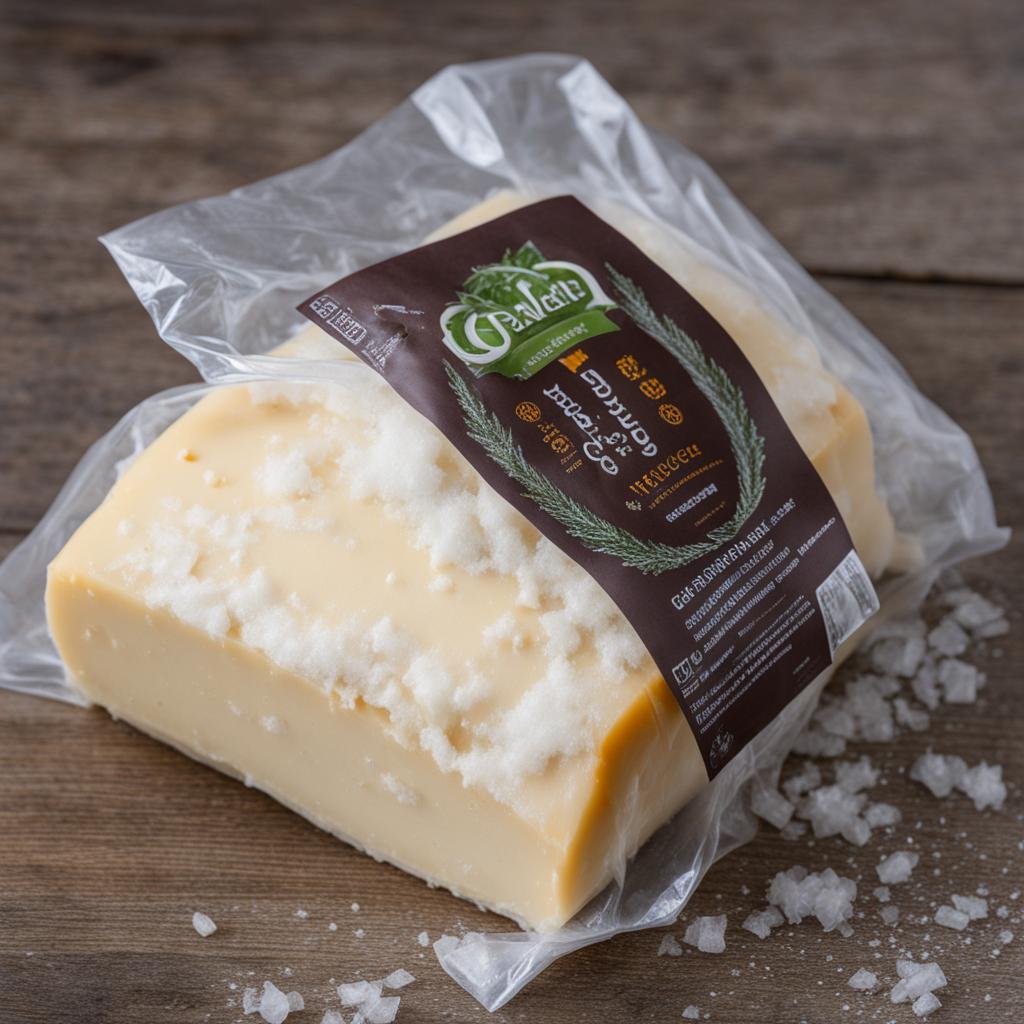As a fan of goat cheese, I’m always looking for ways to ensure its freshness and quality. There’s nothing worse than reaching for a slice of creamy, tangy goodness only to discover that it has gone bad. That’s why I’ve put together this quick guide to help you determine if your goat cheese is still good or if it’s time to say goodbye to that dairy delight.
Key Takeaways:
- Pay attention to the appearance, smell, and texture of goat cheese to determine spoilage.
- Moldy or slimy cheese with a musty or sour smell should not be consumed.
- Check the expiration date and store goat cheese properly in an airtight container in the refrigerator.
- Spoiled goat cheese may have a rubbery texture, unusual color, or mold growth.
- The smell of fresh goat cheese is fresh, tangy, and slightly tart.
- If unsure, take a small taste to confirm spoilage.
- Unopened goat cheese has a shelf life of 2-3 weeks, while opened cheese should be consumed within 1 week.
Signs of Spoiled Goat Cheese: Texture and Appearance
When it comes to determining whether goat cheese has gone bad, paying attention to its texture and appearance is crucial. The changes in these aspects can indicate spoilage and help you avoid consuming spoiled cheese.
Texture: Spoiled goat cheese may develop a slimy or rubbery texture. Instead of its usual creamy and smooth consistency, the cheese might feel unpleasantly sticky or have a rubber-like texture. These changes indicate that the cheese has started to deteriorate.
Appearance: Another sign of spoiled goat cheese is unusual discoloration. If you notice yellowish or brownish spots on the cheese, it is a clear indication of spoilage. Additionally, the growth of mold on the cheese is a definite sign that it has gone bad and should be discarded.
“Spoiled goat cheese may develop a slimy or rubbery texture and exhibit unusual discoloration. The presence of mold on the cheese is a clear sign of spoilage.”
| Signs of Spoiled Goat Cheese | Description |
|---|---|
| Texture | Slimy or rubbery texture instead of creamy and smooth |
| Appearance | Yellowish or brownish spots, mold growth |
By being aware of these signs of spoilage, you can make an informed decision about the quality of goat cheese and avoid potential health risks associated with consuming spoiled cheese. Always prioritize freshness and safety when enjoying this delicious dairy product.
Detecting Spoiled Goat Cheese: Smell Test
When it comes to determining if goat cheese has gone bad, the sense of smell plays a crucial role. A quick smell test can help you detect spoilage and ensure that you’re consuming fresh and safe cheese.
Normally, goat cheese has a fresh, tangy aroma with a slightly tart undertone. This pleasant scent is a sign of the cheese’s freshness and quality. However, if you notice a pungent, moldy, or sour smell coming from the goat cheese, it is likely spoiled and should not be consumed. Trust your sense of smell and err on the side of caution when it comes to the odor of goat cheese.
Remember, consuming spoiled goat cheese can lead to foodborne illnesses, which can cause discomfort and serious health issues. So always rely on your sense of smell to detect any signs of spoilage in goat cheese before consuming it.
“If you notice a pungent, moldy, or sour smell coming from the goat cheese, it is likely spoiled and should not be consumed.”
Reasons for a Pungent Smell
A pungent smell in goat cheese is often a result of bacterial or fungal growth. This can happen if the cheese is not stored properly or if it has exceeded its expiration date. The presence of mold or bacterial contamination can lead to an unpleasant odor that is indicative of spoilage.
It’s important to note that some goat cheeses, especially aged or artisanal varieties, may have a stronger smell naturally due to their unique aging process. However, this is different from a foul or off-putting odor. Trust your senses and avoid consuming goat cheese that has an unusual or unpleasant smell.
Summary:
- A fresh, tangy, and slightly tart smell is characteristic of good goat cheese.
- A pungent, moldy, or sour smell indicates spoilage and should be avoided.
- Proper storage and checking the expiration date are essential for maintaining the freshness of goat cheese.
- Be aware that some goat cheese varieties may naturally have a stronger smell, but it should not be unpleasant.
The Taste Test: Confirming Spoilage
When it comes to determining if goat cheese has gone bad, there’s one surefire way to confirm your suspicions: the taste test. While this may sound daunting, a small taste can provide valuable insight into the freshness or spoilage of the cheese.
Take a small piece of the goat cheese and let it rest on your tongue for a moment. Pay attention to the flavor profile and any off-putting tastes. Spoiled goat cheese often has a sour or unpleasant aftertaste, indicating that it has indeed gone bad.
It’s important to note that if the cheese has a visibly moldy or slimy texture, or a pungent, moldy, or sour smell, it’s best to skip the taste test altogether and discard the cheese immediately.
“I always recommend doing a taste test to confirm if goat cheese has gone bad. Trust your taste buds and if it doesn’t taste right, it’s better to be safe than sorry and throw it out.” – Cheese expert
Table: Signs of Spoiled Goat Cheese
| Texture | Appearance | Taste |
|---|---|---|
| Slime or rubbery texture | Yellowish or brownish spots | Sour or unpleasant aftertaste |
| Visible mold growth |
By conducting a taste test and paying attention to any signs of spoilage, you can confidently decide whether to enjoy your goat cheese or bid it farewell. Remember, when in doubt, it’s best to err on the side of caution and prioritize your health and safety.
Shelf Life of Goat Cheese
When it comes to the shelf life of goat cheese, it’s important to consider both unopened and opened cheese. Unopened goat cheese stored properly in an airtight container in the refrigerator can typically last for 2-3 weeks. This allows you plenty of time to enjoy the cheese at its optimal freshness.
However, once you open the goat cheese, it is best to consume it within 1 week for the best flavor and texture. This ensures that you are getting the most out of your goat cheese experience.
Table:
| Type of Goat Cheese | Shelf Life (Unopened) | Shelf Life (Opened) |
|---|---|---|
| Firm or Hard Goat Cheese | Up to 4 weeks | Up to 2 weeks |
| Soft or Fresh Goat Cheese | 1-2 weeks | Up to 1 week |
| Semi-Soft Goat Cheese | 2-3 weeks | Up to 1 week |
It’s important to note that these are general guidelines and the shelf life may vary depending on the specific brand and quality of the goat cheese. Always check the expiration date and rely on your senses to determine if the cheese has gone bad.
Proper Storage of Goat Cheese
Proper storage is crucial to maintaining the freshness and flavor of goat cheese. Here are some essential tips for storing goat cheese:
- Keep it cool: Goat cheese should be stored in the refrigerator at a temperature between 35°F and 40°F (2°C and 4°C). This helps to slow down the growth of bacteria and extend the shelf life of the cheese.
- Original packaging or airtight container: It is best to store goat cheese in its original packaging. If the original packaging is damaged or not available, transfer the cheese to a clean, airtight container. This helps to prevent the cheese from absorbing odors and moisture from other foods in the refrigerator.
- Avoid direct contact with air: Exposure to air can cause goat cheese to dry out and lose its flavor. To prevent this, cover the cheese tightly with plastic wrap or aluminum foil, ensuring that no air can reach the cheese.
- Keep away from moisture: Excess moisture can promote the growth of mold on goat cheese. Store the cheese away from moisture sources such as uncovered fruits and vegetables or damp areas in the refrigerator.
By following these storage guidelines, you can ensure that your goat cheese stays fresh and delicious for a longer period of time.
“Proper storage is crucial to maintaining the freshness and flavor of goat cheese.”
| Storage Tips | Temperature | Packaging | Air Exposure | Moisture |
|---|---|---|---|---|
| Refrigerate | 35°F – 40°F (2°C – 4°C) | Original or airtight container | Tightly wrapped with plastic wrap or foil | Away from moisture sources |
Proper storage ensures that your goat cheese retains its creamy texture and tangy flavor, providing a delightful addition to your favorite recipes or a tasty snack on its own.
Freezing Goat Cheese for Extended Shelf Life
When it comes to extending the shelf life of goat cheese, freezing can be a handy option. Freezing slows down the natural spoilage process and allows you to enjoy your favorite cheese for a longer period of time. However, it’s important to note that freezing may affect the texture of the cheese, making it more crumbly than its original state.
To freeze goat cheese, start by wrapping it tightly in plastic wrap or placing it in an airtight container. This will help protect the cheese from freezer burn and maintain its flavor. It’s recommended to divide the cheese into smaller portions before freezing, so you can thaw only the amount you need at a time.
When you’re ready to use the frozen goat cheese, thaw it in the refrigerator overnight. Avoid thawing at room temperature, as this can lead to excessive moisture and compromise the quality of the cheese. Once thawed, the goat cheese can be enjoyed in various dishes, from salads to pastas, adding a tangy and creamy flavor to your culinary creations.
Remember to label the frozen goat cheese with the date of freezing to keep track of its freshness. Generally, frozen goat cheese can be stored for several months, but it’s best to consume it within a reasonable timeframe to ensure optimal taste and quality.

Table: Freezing Goat Cheese Tips
| Step | Instructions |
|---|---|
| 1 | Wrap the goat cheese tightly in plastic wrap or place it in an airtight container. |
| 2 | Divide the cheese into smaller portions before freezing. |
| 3 | Label the frozen goat cheese with the date of freezing. |
| 4 | Thaw the cheese in the refrigerator overnight. |
| 5 | Use the thawed goat cheese within a reasonable timeframe for optimal taste and quality. |
Different Types of Goat Cheese and Their Shelf Life
When it comes to goat cheese, there are various types available, each with its own unique characteristics. Understanding the different types can help you choose the right goat cheese for your culinary needs. Additionally, knowing the shelf life of each type is crucial for maintaining freshness and quality.
Fresh Goat Cheese
Fresh goat cheese, also known as chevre, is soft and creamy with a mild flavor. It is typically consumed within a few days of production and has a short shelf life. When stored properly in the refrigerator, fresh goat cheese can stay fresh for up to 7 days after opening.
Aged Goat Cheese
Aged goat cheese, also called ripened or hard goat cheese, undergoes a longer aging process, resulting in a firmer texture and stronger flavor. The shelf life of aged goat cheese is longer compared to fresh goat cheese. Properly stored in the refrigerator, it can last for 2-4 weeks after opening.
Goat Cheese Logs
Goat cheese logs are cylindrical in shape and often rolled in various herbs or spices. These logs can be either fresh or aged, depending on the desired flavor profile. Fresh goat cheese logs have a shorter shelf life, similar to fresh goat cheese, while aged goat cheese logs have a longer shelf life, similar to aged goat cheese.
Goat Cheese Wheels
Goat cheese wheels are larger rounds of cheese that can be either fresh or aged. Fresh goat cheese wheels have a shorter shelf life, similar to fresh goat cheese, while aged goat cheese wheels have a longer shelf life, similar to aged goat cheese. The size of the wheel may also affect the shelf life, with larger wheels aging more slowly.
In summary, the shelf life of goat cheese varies depending on its type. Fresh goat cheese has a shorter shelf life of about 7 days, while aged goat cheese can last for 2-4 weeks. Proper storage in the refrigerator is crucial for maintaining the quality and freshness of goat cheese.
| Type of Goat Cheese | Texture | Flavor | Shelf Life |
|---|---|---|---|
| Fresh Goat Cheese (Chevre) | Soft and creamy | Mild | Up to 7 days after opening |
| Aged Goat Cheese | Firm | Strong | 2-4 weeks after opening |
| Goat Cheese Logs | Varies (fresh or aged) | Varies (mild or strong) | Depends on type (similar to fresh or aged goat cheese) |
| Goat Cheese Wheels | Varies (fresh or aged) | Varies (mild or strong) | Depends on type and size (similar to fresh or aged goat cheese) |
Understanding and considering the different types of goat cheese and their respective shelf lives can help you make informed decisions in the kitchen. Whether you’re adding a touch of creaminess to a salad or enjoying the robust flavors of an aged goat cheese, knowing how long each type can be stored will ensure you’re experiencing the best that goat cheese has to offer.
Potential Risks of Consuming Spoiled Goat Cheese
Consuming spoiled goat cheese can pose various health risks. Spoiled cheese can be contaminated with harmful bacteria, such as Listeria monocytogenes or Salmonella, which can cause foodborne illnesses. These bacteria can multiply and thrive in the warm and humid conditions that promote cheese spoilage. It is important to be aware of the potential risks associated with consuming spoiled goat cheese to protect your health.
Symptoms of foodborne illnesses caused by consuming spoiled goat cheese may include sweating, shivering, abdominal pain, diarrhea, nausea, vomiting, and fever. These symptoms can vary in severity depending on the individual and the type and amount of bacteria ingested. In severe cases, medical attention may be required to treat complications and prevent further health problems.
To avoid the risks associated with spoiled goat cheese, it is crucial to practice proper food safety and hygiene. This includes checking the appearance, smell, and texture of the cheese before consuming it. If any signs of spoilage are present, it is best to discard the cheese to prevent potential illness. Additionally, it is important to store goat cheese properly and adhere to expiration dates to maintain its freshness and reduce the risk of spoilage.
“Consuming spoiled goat cheese can lead to foodborne illness. It is possible to experience symptoms such as sweating, shivering, abdominal pain, diarrhea, nausea, vomiting, and fever. In severe cases, medical attention may be required.”

| Risks of Consuming Spoiled Goat Cheese | Preventive Measures |
|---|---|
| Foodborne illness | Check the appearance, smell, and texture of the cheese before consumption. Discard any spoiled cheese. |
| Bacterial contamination | Store goat cheese properly in an airtight container in the refrigerator. Adhere to expiration dates. |
| Severe symptoms | Seek medical attention if experiencing severe symptoms after consuming spoiled goat cheese. |
Substitutes for Goat Cheese
If you find yourself in a situation where goat cheese is spoiled or unavailable, don’t worry! There are several substitutes that can be used to achieve similar flavors and textures in your recipes. Whether you’re lactose intolerant, vegan, or simply looking for alternatives, these options won’t disappoint.
Ricotta Cheese
If you’re looking for a creamy substitute, ricotta cheese is a great option. It has a mild flavor and a similar creamy texture to goat cheese. Use it in recipes that call for goat cheese as a spread or filling, such as on toast or in stuffed pasta shells.
Cream Cheese
Cream cheese is another suitable substitute for goat cheese. It has a smooth and creamy consistency, making it perfect for spreading on bagels or using as a base for dips. It’s important to note that cream cheese has a slightly different taste, so adjust seasonings accordingly.
Feta Cheese
If you’re looking for a tangy and salty flavor similar to goat cheese, feta cheese is a great choice. It crumbles easily and can be used as a topping for salads, pizzas, or roasted vegetables. Its distinct flavor adds a unique touch to your dishes.
Blue Cheese
For those who enjoy strong flavors, blue cheese can be used as a substitute for goat cheese. It has a sharp and tangy taste that pairs well with fruits, nuts, and salads. Use it in recipes that call for goat cheese crumbles or as a flavor enhancer in creamy sauces.
Silken Tofu (Vegan Option)
If you follow a vegan diet or prefer plant-based alternatives, silken tofu can be used as a substitute for goat cheese. Its smooth and creamy texture makes it suitable for blending into dressings, sauces, or desserts. You can also marinate it with herbs and spices to mimic the flavor of goat cheese.
Try these substitutes whenever you need to replace goat cheese in your favorite recipes. Whether you’re looking for a similar taste, texture, or dietary preference, these options offer versatility and deliciousness.
Expert Tips for Goat Cheese Selection
When it comes to choosing the perfect goat cheese, there are a few expert tips that can help you make the best selection. By considering the appearance, smell, and texture of the cheese, you can ensure that you are getting a high-quality product.
Appearance
When examining goat cheese, look for bright and dry cheese without any signs of mold or discoloration. The surface should be smooth and free from any slimy or sticky residue. Additionally, the color should be uniform and consistent throughout the cheese.
Smell
The aroma of goat cheese should be fresh, tangy, and slightly tart. Avoid cheeses with a pungent or ammonia-like smell, as this can indicate spoilage. A pleasant and appetizing smell is a good indication that the cheese is of good quality.
Texture
The texture of goat cheese can vary depending on the type and age. Firmer goat cheese should be smooth and slightly crumbly, while softer varieties should be creamy and spreadable. Avoid cheese with a rubbery or grainy texture, as this can be a sign of poor quality.
By following these expert tips, you can confidently select the perfect goat cheese for your culinary creations. Remember to check the expiration date and purchase from reliable sources to ensure the freshness and safety of your cheese.
Frequently Asked Questions about Goat Cheese
As a popular and versatile cheese, it’s no surprise that many people have questions about goat cheese. Here are some frequently asked questions and their answers:
Q: How long does goat cheese last?
A: The shelf life of goat cheese can vary depending on its type and how it is stored. Unopened goat cheese can typically be kept in the refrigerator for 2-3 weeks. Once opened, it should be consumed within 1 week for the best quality and flavor.
Q: Can I freeze goat cheese?
A: Yes, goat cheese can be frozen to extend its shelf life. However, freezing may affect the texture of the cheese, making it more crumbly. It is recommended to wrap the cheese tightly in plastic wrap or place it in an airtight container before freezing. Thaw frozen goat cheese in the refrigerator overnight before using.
Q: How can I tell if goat cheese has gone bad?
A: To determine if goat cheese has spoiled, use your senses. Look for signs of mold, unusual color, or sliminess. If the cheese has a strong, pungent odor or a sour smell, it is likely spoiled. Additionally, if the texture is rubbery or slimy, it’s best to discard the cheese.
Q: Can I substitute goat cheese in recipes?
A: Absolutely! If goat cheese is not available or you prefer a different flavor, there are several substitutes you can use. Ricotta cheese, cream cheese, feta cheese, blue cheese, and even silken tofu can be used as alternatives in recipes that call for goat cheese. Each substitute will bring its own unique flavor and texture to the dish.
| Question | Answer |
|---|---|
| Q: How long does goat cheese last? | A: The shelf life of goat cheese can vary depending on its type and how it is stored. Unopened goat cheese can typically be kept in the refrigerator for 2-3 weeks. Once opened, it should be consumed within 1 week for the best quality and flavor. |
| Q: Can I freeze goat cheese? | A: Yes, goat cheese can be frozen to extend its shelf life. However, freezing may affect the texture of the cheese, making it more crumbly. It is recommended to wrap the cheese tightly in plastic wrap or place it in an airtight container before freezing. Thaw frozen goat cheese in the refrigerator overnight before using. |
| Q: How can I tell if goat cheese has gone bad? | A: To determine if goat cheese has spoiled, use your senses. Look for signs of mold, unusual color, or sliminess. If the cheese has a strong, pungent odor or a sour smell, it is likely spoiled. Additionally, if the texture is rubbery or slimy, it’s best to discard the cheese. |
| Q: Can I substitute goat cheese in recipes? | A: Absolutely! If goat cheese is not available or you prefer a different flavor, there are several substitutes you can use. Ricotta cheese, cream cheese, feta cheese, blue cheese, and even silken tofu can be used as alternatives in recipes that call for goat cheese. Each substitute will bring its own unique flavor and texture to the dish. |
Conclusion
Ensuring the freshness and safety of goat cheese is essential for enjoyable and healthy consumption. By carefully examining the appearance, smell, and texture of the cheese, you can determine if it has gone bad. Moldy or slimy cheese with a musty or sour smell should be discarded. Additionally, proper storage in an airtight container in the refrigerator is crucial to maintaining the quality of goat cheese.
It is important to note that consuming spoiled goat cheese can lead to foodborne illness. Symptoms such as abdominal pain, diarrhea, nausea, and fever may occur. To avoid these risks, it is best to err on the side of caution and discard any questionable cheese.
Although goat cheese has a relatively short shelf life, it can be extended by freezing. However, it is important to be aware that the texture of frozen goat cheese may change, becoming more crumbly. Thaw frozen goat cheese in the refrigerator overnight before consuming for the best results.
By following these guidelines and tips, you can confidently enjoy the creamy and tangy flavors of goat cheese while ensuring its freshness and safety.
Additional Culinary Uses for Goat Cheese
Goat cheese, with its creamy and tangy flavor, is not only a versatile ingredient but also a delightful addition to a variety of culinary creations. Whether you’re looking to elevate your appetizers, salads, pasta dishes, or pizzas, goat cheese adds a unique and delicious twist to your favorite recipes. Here are some creative culinary uses for goat cheese:
1. Spread on Crackers
One of the simplest ways to enjoy the creamy goodness of goat cheese is by spreading it on crackers. Its tangy flavor pairs perfectly with the crunch of the crackers, creating a delightful appetizer or snack. Top it off with a drizzle of honey, a sprinkle of herbs, or some sliced fruits for added sweetness and freshness.
2. Add to Salads
Goat cheese can take your salads to the next level. Crumble it over fresh greens and vegetables for a burst of flavor and a creamy texture. The tanginess of the cheese complements the freshness of the salad, creating a harmonious balance of flavors. Pair it with some nuts, dried fruits, or a tangy vinaigrette to enhance the overall taste.
3. Melt in Pasta Dishes
Add depth and richness to your pasta dishes by melting goat cheese into the sauce. Its creamy texture and tangy taste create a luscious and velvety sauce that coats every strand of pasta. Mix it with some herbs, garlic, or even sun-dried tomatoes for a burst of flavor that will delight your taste buds.
4. Use as a Pizza Topping
Take your homemade pizza to a gourmet level by using goat cheese as a topping. Its tangy and creamy nature adds a unique dimension of flavor to the pizza. Combine it with other ingredients like caramelized onions, roasted vegetables, or even prosciutto for a delicious and sophisticated pizza experience.
With these culinary uses, goat cheese can transform your dishes into gourmet creations. Its creamy and tangy flavors add depth and complexity, making it a favorite ingredient among chefs and home cooks alike. So get creative in the kitchen and discover the endless possibilities of goat cheese!
Goat Cheese in Gourmet Cuisine
Goat cheese holds a special place in the world of gourmet cuisine, captivating the palates of food enthusiasts and chefs alike. Its distinct flavor, creamy texture, and tangy taste make it a versatile ingredient that elevates the dining experience to a new level.
In gourmet cheese plates, goat cheese often takes center stage, offering a delightful combination of savory and tangy notes. It pairs beautifully with a variety of accompaniments, such as fresh fruits, cured meats, and artisanal bread. The creamy richness of the goat cheese perfectly balances the flavors and textures, creating a harmonious blend that pleases the senses.
But goat cheese doesn’t stop at cheese plates. It finds its way into upscale culinary creations, adding a touch of elegance and sophistication to dishes. From delicate pastries and quiches to gourmet salads and main courses, goat cheese imparts a unique depth of flavor that brings complexity to every bite. Its versatility allows it to seamlessly complement both savory and sweet dishes, making it a staple in the repertoire of gourmet chefs.
Goat cheese is a staple in gourmet cuisine, providing a creamy and tangy flavor that enhances a variety of dishes. Its presence on cheese plates and in upscale recipes showcases its versatility and ability to elevate the dining experience.
Whether crumbled over a mixed greens salad, melted into a luscious pasta sauce, or incorporated into a decadent dessert, goat cheese stands out as a star ingredient in gourmet cuisine. Its presence on menus signifies a commitment to quality and a desire to create memorable dining experiences. For those with a keen appreciation for culinary artistry, goat cheese is a must-have ingredient.
Recommended Recipes with Goat Cheese
Are you looking to incorporate the delicious flavors of goat cheese into your culinary creations? Look no further! I’ve curated a selection of mouthwatering recipes that showcase the versatility and creamy tanginess of goat cheese.
1. Goat Cheese-Stuffed Chicken Breast
Elevate your chicken dish with a savory and creamy goat cheese filling. Simply butterfly boneless, skinless chicken breasts and stuff them with a mixture of goat cheese, fresh herbs, and garlic. Bake until the chicken is cooked through and the goat cheese filling is melty and irresistible. Serve it alongside a crisp green salad for a complete and satisfying meal.
2. Roasted Beet and Goat Cheese Salad
Indulge in the vibrant colors and flavors of this refreshing salad. Start by roasting beets until tender. Once cooled, slice them and arrange them on a bed of mixed greens. Crumble tangy goat cheese over the top and sprinkle with roasted walnuts for added crunch. Drizzle with a balsamic vinaigrette and enjoy a refreshing salad that is both visually stunning and delectable.
3. Goat Cheese and Spinach Stuffed Mushrooms
Impress your guests with these elegant and flavorful stuffed mushrooms. Remove the stems from large mushrooms and stuff them with a mixture of goat cheese, sautéed spinach, and garlic. Bake them until the mushrooms are tender and the cheese is golden and bubbly. These stuffed mushrooms make for a delightful appetizer or a crowd-pleasing side dish.
These recipes are just a taste of the many culinary possibilities that goat cheese offers. Whether you’re a seasoned chef or a culinary enthusiast, these dishes will surely tantalize your taste buds and leave you craving more. So go ahead, incorporate goat cheese into your next culinary adventure and savor the creamy and tangy flavors it brings to your table.
FAQ
How can I tell if goat cheese has gone bad?
To determine if goat cheese has gone bad, you should consider its appearance, smell, and texture. Moldy or slimy cheese with a musty or sour smell should not be consumed.
What are the signs of spoiled goat cheese?
Spoiled goat cheese may have a slimy or rubbery texture and may develop unusual yellowish or brownish spots. Mold growth on the cheese is also a clear sign of spoilage.
How can I detect spoiled goat cheese using the smell test?
Fresh goat cheese should have a fresh, tangy, and slightly tart smell. If the cheese has a pungent, moldy, or sour smell, it is likely spoiled.
Can I confirm spoilage by taste testing goat cheese?
If unsure about the freshness of goat cheese, you can take a small taste. Spoiled goat cheese may have a sour or unpleasant aftertaste.
What is the shelf life of goat cheese?
Unopened goat cheese typically has a shelf life of 2-3 weeks when stored properly in the refrigerator. Once opened, it should be consumed within 1 week for optimal freshness.
How should goat cheese be stored?
Goat cheese should be stored in the refrigerator in its original container or in a separate airtight container to prevent bacterial growth. It is important to keep the cheese cool and away from moisture.
Can goat cheese be frozen?
Yes, goat cheese can be frozen to extend its shelf life by several months. However, freezing may affect the texture, making it more crumbly. Thaw frozen goat cheese in the refrigerator overnight before consuming.
Do different types of goat cheese have different shelf lives?
Yes, firmer or harder goat cheese typically has a longer shelf life compared to soft and fresh goat cheese. However, all types should be consumed within a week of opening for optimal freshness.
Are there any health risks associated with consuming spoiled goat cheese?
Consuming spoiled goat cheese can lead to foodborne illness. Symptoms may include sweating, shivering, abdominal pain, diarrhea, nausea, vomiting, and fever. Seek medical attention if symptoms are severe.
What are some substitutes for goat cheese?
If goat cheese is spoiled or unavailable, you can use substitutes such as ricotta, cream cheese, feta cheese, blue cheese, and silken tofu (for a vegan option). These provide similar flavors and textures in recipes.
What should I look for when selecting goat cheese?
Look for bright and dry cheese with no signs of mold or discoloration. Choose cheese with a fresh, tangy aroma and a consistent texture. Check the expiration date and buy from reliable sources.
What are some common questions about goat cheese?
Common questions about goat cheese include its shelf life, proper storage, and potential health risks.
Source Links
- https://homecookbasics.com/how-to-tell-if-goat-cheese-has-gone-bad/
- https://medmunch.com/how-to-tell-if-goat-cheese-is-bad/
- https://saralovecooking.com/how-to-tell-if-goat-cheese-has-gone-bad/
Related Recipes:
 How to Tell if Cheese is Bad: A Comprehensive Guide
How to Tell if Cheese is Bad: A Comprehensive Guide
 How to Tell if Ground Pork is Bad: Health Guidelines
How to Tell if Ground Pork is Bad: Health Guidelines
 Does Peanut Butter Go Bad? Shelf Life and Storage Tips
Does Peanut Butter Go Bad? Shelf Life and Storage Tips
 How to Identify Spoiled Canned Foods
How to Identify Spoiled Canned Foods
 Does Almond Milk Go Bad? How to Tell and Storage Tips.
Does Almond Milk Go Bad? How to Tell and Storage Tips.
 Spotting Spoiled Blue Cheese: How to Tell If Blue Cheese is Bad
Spotting Spoiled Blue Cheese: How to Tell If Blue Cheese is Bad
 How to Tell if Jelly Has Gone Bad: Preserving Quality
How to Tell if Jelly Has Gone Bad: Preserving Quality
 Can You Eat Expired Butter? What You Need to Know
Can You Eat Expired Butter? What You Need to Know








